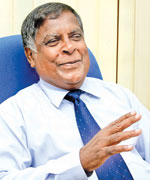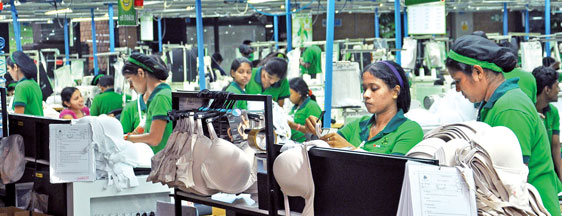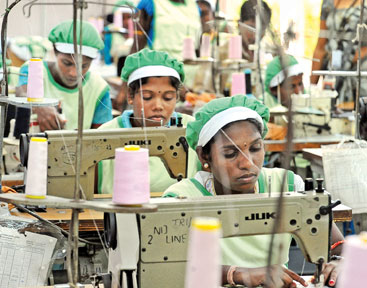Apparel industry will overcome challenges - Secretary General, JAAF
By Gamini Warushamana
"The apparel industry in Sri Lanka has overcome difficult situations.
Today we face new issues such as labour shortage and cost increase. We
will use our skilled knowledge base and develop the front-end of the
industry based in Colombo, providing services to manufacturers and
market products using our brands as reputed apparel manufacturers. This
is the new era of the Sri Lankan apparel industry," said the Secretary
General of the Joint Apparel Association Forum (JAAF), M.P.T Cooray in
an exclusive interview with Sunday Observer Business.
 |
|
M.P.T Cooray |
Q. How do you see the growth of the apparel industry during the past
five years? Is there a setback or slowing down in growth?
A. In terms of exports there has been continuous growth since 2008 in
the two main markets, the US and the EU except for a dip in 2009. In
2008, total apparel exports were at $ 3.3 billion and due to global
recession it declined to $ 3.16 billion in 2009.
Since then export growth continued and it was $ 3.36 billion in 2010
and $ 4.03 billion in 2011. The industry had set a target of $ 4 billion
in exports by 2016 and we reached the target in 2011. Again there was a
5.3 percent drop in exports in 2012 and the total apparel exports
recorded $ 3.8 billion.
There are several reasons for the decline in 2012 and it is
associated with the sharp increase of exports in 2011. In 2011, there
was a significant increase in cotton prices and as a result, prices
increased. On the other hand, the changing situation in other apparel
exporting countries such as cost increase in China and Bangladesh and
disturbances in Egypt created favourable conditions for Sri Lanka. When
the GSP+ was withdrawn, it had no impact because by then orders had
already been undertaken.
In 2012, the situation was different and both major markets were
suffering from recession and imports had shrunk. However, the percentage
decline in apparel exports was less than the decline of total exports to
those countries.
Secondly cotton prices stabilised in 2012 and it affected turnover.
Thirdly, a few companies suffered as a result of the withdrawal of
the GSP+, because they depended on concessions and they had to find new
markets.
By and large the Sri Lankan apparel sector is no longer a footloose
industry and could shift to other countries and stabilise. However,
competition from countries such as Bangladesh, Vietnam and India is
intensifying and we now face a competitive environment. This 5.3 percent
decline is a result of all these factors.
We continue to be one of the main players in the EU market, because
despite a distorted picture of Sri Lanka being painted internationally,
we continue to enjoy the general GSP facility which reflects that we
maintain labour and other standards. Other than this facility we don't
have any other concessions.
The Sri Lankan apparel industry is always forward looking. In 2005,
when the quota system was abolished it was envisaged that the apparel
industry would collapse.
 However, the industry decided to accept the challenge and we did it
strategically. Concentrating on new initiatives in managing the supply
chain and facing an increasingly competitive environment have been done
successfully. As a result we became a total solution provider instead of
low-end manufacturers. However, the industry decided to accept the challenge and we did it
strategically. Concentrating on new initiatives in managing the supply
chain and facing an increasingly competitive environment have been done
successfully. As a result we became a total solution provider instead of
low-end manufacturers.
Apparel exports have increased from $ 2.7 billion in 2005 to $ 3.8
billion today. No other industry in Sri Lanka has faced adverse
situations as the apparel sector and we have confidence that we can
overcome whatever adverse conditions we encounter domestically or
internationally.
With regard to value addition, today the apparel industry of Sri
Lanka is not totally import-dependent on raw material. Because we
invested heavily on input-manufacturing such as fabric, packing
materials and accessories. Today our value-addition is more than 55
percent and this gives us a competitive edge.
We also have established brands and Sri Lanka is known as a quality
and timely apparel supplier. We continuously attempt to improve our
position. Therefore we can say the apparel industry of Sri Lanka is
growing despite challenges.
Q. Investments coming into the industry is declining while some of
the leading manufacturers are shifting to other countries. What are the
reasons?
A. We do not believe there is a decline in investments. We don't have
statistics of Foreign Direct Investment (FDI) which come into the
apparel sector. However, setting up factories overseas by large Sri
Lankan apparel companies does not mean declining investments in the
sector. In the event they close factories here and shift to other
countries then the argument stands.
The investment in the apparel sector has changed over time. In 2005,
when the Multi Fibre Agreement with the US was in place there were
around 800 garment factories. But exports were low as $ 2.5 billion.
Today there are around 350 factories but exports total $ 3.8 billion.
Over time the industry has consolidated while companies depending on
quotas faded away.
Today the apparel industry is in a competitive environment and
companies have their own marketing strategies and are doing well. These
large companies well connected to markets have become regional players
in manufacturing. They get orders to Sri Lanka, manufacture it in other
countries which have cost advantages, add value in Sri Lanka and export.
They are only looking for low cost centres and have not ceased their
production here. To facilitate this new environment the regulatory
framework has to be changed. Therefore, there is no decline in
investments in the apparel industry and local investments are coming in.
Q. Labour shortage is a serious issue and there is an allegation by
trade unions that the industry has not solved the real issues and merely
carry out promotional campaigns. What is your response?
A. Yes we do have a problem. But we don't believe that workers are
leaving the industry because we do not pay living wages to them. Our
understanding is that the labour shortage is heavily felt by the SMEs
concentrated in and around Colombo. Reports say that there are over
30,000 vacancies in EPZs, but the 30,000 are not all in the apparel
industry, because most of the garment factories are not in EPZs.
One major reason for labour shortage is the perception of the people.
The social stigma attached to the apparel industry is a major issue. Job
security is another reason. Wages are not the issue because there are
other industries or sectors that pay lower salaries but there is no
shortage of workers. For instance, graduates prefer government sector
jobs even at a salary of Rs. 10,000.
On the other hand, we are the only visible industry that grew over
the past three decades. There was no competition in the labour market
from other industries. With the peace dividend other sectors are
emerging. New super- markets, the IT BPO industry, tourism projects are
coming up and there is competition in the labour market. Young people
prefer office-oriented work rather than a factory environment and
therefore a labour shortage is natural.
However, most of the garment factories are in rural areas all over
the country and they have not felt a severe labour shortage.
A proposal was made to JAAF requesting the right to import labour.
But we unanimously rejected it because it was not commercially feasible.
The cost that will be incurred will be dictated by various international
regulations and there are other costs as well. If these costs can be
paid then there is a possibility of diverting Sri Lankan migrant workers
to the apparel industry. Today, that is what we are trying to do.
 Despite all these issues, our wages are higher than the minimum
stipulated wage. If we don't pay a living wage as claimed by some
quarters, two things could happen. Workers will shift to other
industries or migrate. Neither of this happened in garment factories in
rural areas and in addition to reasonable wages they receive other
benefits such as transport and free meals. Despite all these issues, our wages are higher than the minimum
stipulated wage. If we don't pay a living wage as claimed by some
quarters, two things could happen. Workers will shift to other
industries or migrate. Neither of this happened in garment factories in
rural areas and in addition to reasonable wages they receive other
benefits such as transport and free meals.
However, to address issues faced by companies in the Western Province
we have implemented a plan to relocate these industries in rural areas.
The apparel industry of Sri Lanka always faces challenging situations.
In this case too we have a plan to use our highly skilled knowledge base
and develop the front-end of the industry based in Colombo and provide
services and market the products as reputed apparel manufacturers.
There is a new supply chain management strategy and new business
plan. For this we need a new regulatory framework that facilitates
trade, transshipment, logistics and a new method of manufacture. This
includes obtaining orders and manufacturing in other countries. This
will create business opportunities for ports, airports and other
sectors. We started this process three years ago and this is also a
solution to the labour shortage. With all these plans we have revised
our targets and expect to achieve $ 5 billion exports by 2016. This is
the new evolution of the apparel industry.
Q. How does the new electricity tariff structure impact on the
apparel industry?
A. The electricity tariff increase will jam our cost structure and
the tariff increase for apparel factories will be around 15 percent. The
cost increase of textile manufacturers' washing and dying plants will be
enormous.
During our discussions with the Public Utility Commission (PUC) we
requested them to consider the serious impact of the tariff increase on
the export sector and repercussions on the economy and give us
opportunities to face global competition.
However, they have not considered our request and we are disappointed
with the authorities not creating a conducive environment for export
industries.
Competitiveness is the key element in the export industry. We produce
for export not local markets. Our basic difficulty would be the demand
for price increases by all stakeholders in the supply chain. Over 50
percent of the value-adding industry cannot absorb any other cost
because there is no any preferential treatment and labour and other
costs too have increased. |


